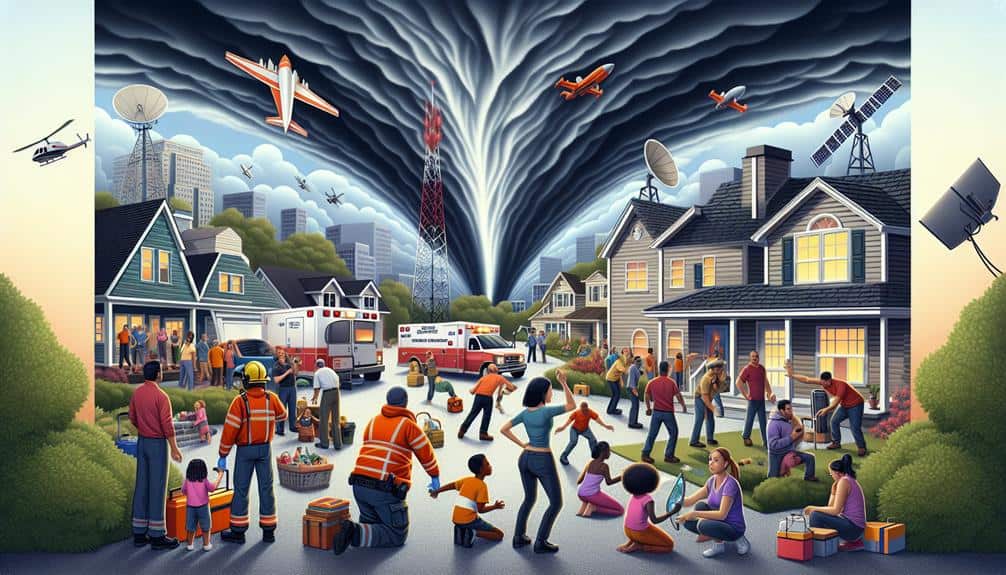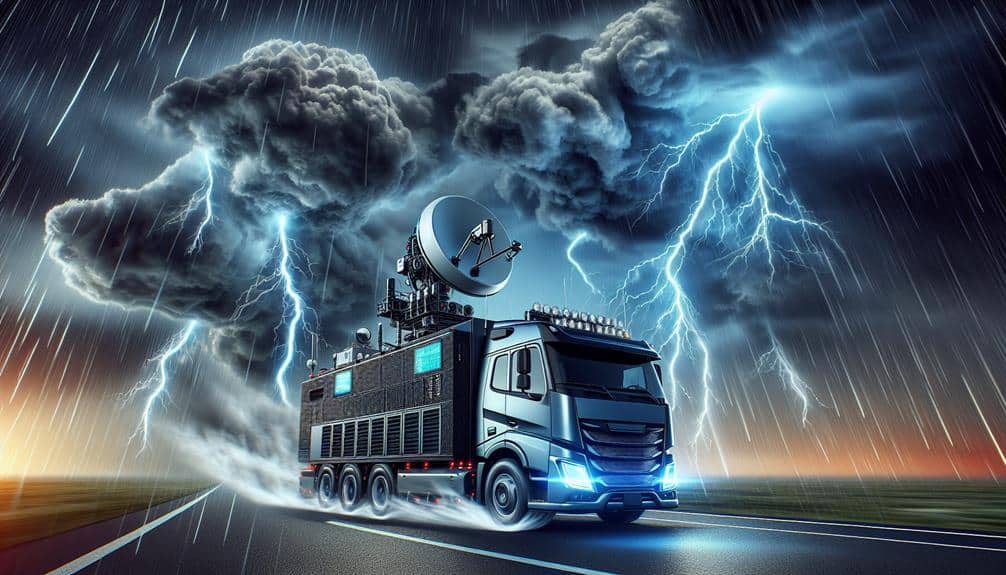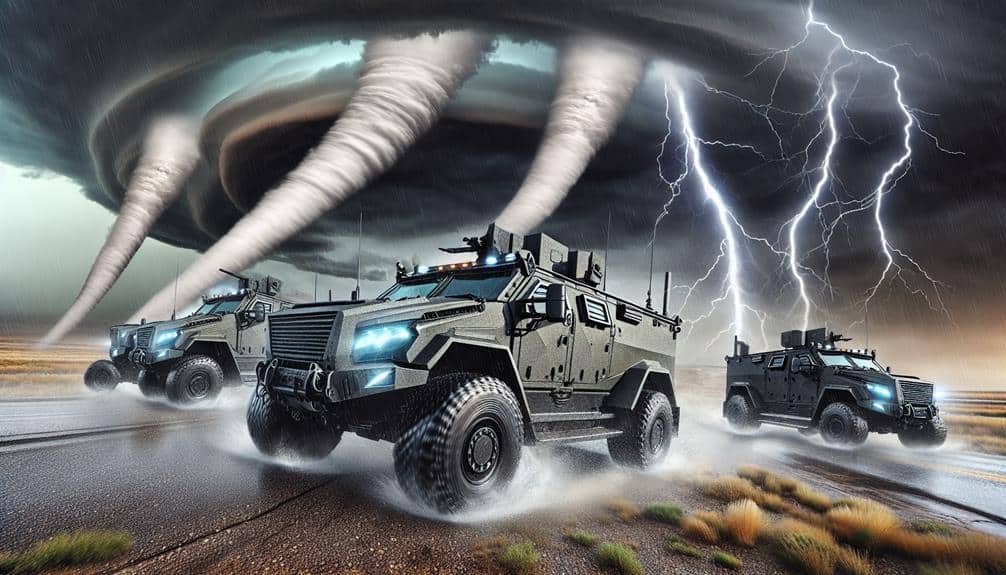We rely on advanced storm prediction tools to enhance safety, improve forecast accuracy, and efficiently manage emergency responses. Leveraging technologies like remote sensing, Doppler radar, and machine learning, we can analyze real-time data to predict severe weather with precision. Early warnings guarantee timely evacuations, while accurate forecasts enable better resource allocation and infrastructure fortification. This integrated approach not only saves lives but also reduces economic impacts on communities. By understanding storm paths and intensities, we can prepare more effectively and minimize damage. Want to see how technology changes our weather preparedness more drastically? Stay tuned.
Key Points
- Early and accurate warnings ensure timely evacuations, reducing casualties and property damage.
- Enhanced forecasting improves community preparedness and emergency response effectiveness.
- Real-time data analysis allows for swift interpretation of meteorological conditions.
- Machine learning models provide reliable storm predictions, enhancing overall forecast accuracy.
Enhanced Tornado Detection
Advanced tornado detection has transformed our capacity to predict and respond to these destructive natural occurrences with greater accuracy and speed. By utilizing cutting-edge technologies like remote sensing and Doppler radar, we've enhanced our forecasting capabilities.
Remote sensing enables us to observe atmospheric conditions from satellites, offering detailed data on temperature, humidity, and wind patterns. This detailed data is essential for identifying the precursors of tornado formation.
Doppler radar, on the flip side, plays a central role in detecting tornadoes. It gauges the speed of particles within a storm, allowing us to pinpoint rotating winds linked with tornadoes. The dual-polarization radar technology enhances this ability by distinguishing between various forms of precipitation, aiding us in identifying the precise location and intensity of tornadoes.
With these tools, we can issue tornado warnings earlier and with more accuracy. This reduces false alarms and guarantees timely evacuations, thereby protecting lives and property.
Real-time Data Analysis
Leveraging real-time data analysis, we can rapidly interpret vast amounts of meteorological information to improve storm prediction accuracy. By utilizing cutting-edge data visualization techniques, we can transform raw data into intuitive graphics and maps, making complex weather patterns more understandable. This allows us to identify critical trends and anomalies that might otherwise go unnoticed.
Predictive modeling plays an essential role in our approach. By integrating real-time data with sophisticated algorithms, we generate models that forecast storm development and movement with remarkable precision. These models aren't static; they continuously evolve as new data streams in, ensuring our predictions remain current and reliable.
Moreover, accessing real-time data empowers us to make informed decisions swiftly. Instead of waiting for periodic updates, we've continuous insights into atmospheric changes. This immediacy is invaluable for issuing timely warnings and taking proactive measures to safeguard communities.
Our ability to analyze data in real-time liberates us from the constraints of traditional weather prediction methods. With advanced tools at our disposal, we can anticipate storms more effectively, ultimately enhancing our preparedness and resilience in the face of nature's unpredictability.
Improved Forecast Accuracy
By integrating machine learning algorithms with high-resolution satellite data, we're significantly enhancing the accuracy of storm forecasts. This data integration allows us to leverage vast amounts of information, leading to more precise predictions. As a result, we can better anticipate storm paths, intensities, and timing, giving us the freedom to make more informed decisions.
Here's how technology advancement is improving our forecast accuracy:
- Enhanced Data Collection: By using high-resolution satellite imagery, we capture detailed atmospheric data. This helps us understand storm development in real-time.
- Machine Learning Models: These models analyze historical and current data to predict future storm behavior. They continually learn and improve, making our forecasts increasingly reliable.
- Improved Computational Power: With advancements in computing technology, we're able to process complex data sets quickly. This speed is essential for timely storm predictions.
- Integration of Multiple Data Sources: Combining data from satellites, radar, and ground sensors creates a thorough picture of storm conditions, enhancing our predictive capability.
Safety and Preparedness
Utilizing these advanced storm prediction tools, we can greatly enhance community safety and preparedness by providing early warnings and actionable insights. Early warnings are vital for initiating timely emergency response protocols, allowing us to mobilize resources, evacuate vulnerable areas, and safeguard lives.
With precise data on potential storm paths and intensities, emergency response teams can allocate their efforts more effectively, reducing the storm's impact on our communities.
Advanced storm prediction also plays a significant role in weather education. By understanding the science behind these tools, we empower individuals with knowledge, fostering a culture of preparedness. Weather education initiatives can leverage prediction data to teach people how to interpret storm warnings and take appropriate actions.
This proactive approach ensures that when a storm is imminent, everyone knows exactly what to do, thereby minimizing chaos and confusion.
Moreover, these tools facilitate better coordination between various agencies involved in emergency response. Real-time data sharing ensures all stakeholders—from local governments to first responders—are on the same page. This unified approach not only enhances our collective response capabilities but also maximizes the efficiency of our preparedness efforts, ultimately preserving our freedom and security.
Community Impact

Advanced storm prediction tools greatly enhance our community's resilience by providing actionable data that informs timely decision-making and resource allocation. By understanding the potential severity and trajectory of storms, we can better prepare and protect our neighborhoods. This knowledge is especially vital for our emergency response teams, who rely on precise information to act swiftly and effectively.
Here are four key ways these tools impact our community:
- Improved Emergency Response: Advanced predictions allow emergency services to deploy resources preemptively, reducing response times and potentially saving lives.
- Minimized Infrastructure Damage: Accurate forecasts enable local governments to fortify vulnerable infrastructure, such as bridges and power lines, before storms strike.
- Enhanced Communication: With reliable data, we can keep the public informed, ensuring everyone understands the risks and necessary precautions.
- Economic Savings: By mitigating the effects of severe weather, we can avoid extensive repairs and reduce the economic impact on our community.
Utilizing advanced storm prediction tools empowers us to take proactive measures, safeguarding our homes, businesses, and families. The precision and reliability of these tools aren't just about forecasting weather; they're about preserving our way of life and ensuring our community thrives, no matter what nature throws our way.
Frequently Asked Questions
How Do Advanced Storm Prediction Tools Integrate With Existing Weather Monitoring Systems?
We integrate advanced storm prediction tools with existing weather monitoring systems through seamless data integration and leveraging technology advancements. This guarantees real-time updates, enhances accuracy, and provides us the freedom to make informed, proactive decisions.
What Are the Limitations of Current Storm Prediction Technologies?
A chain is only as strong as its weakest link. Current storm prediction technologies face data integration issues, affecting forecast accuracy. Technology gaps exist, highlighting the need for future improvements to enhance our predictive capabilities.
How Do Funding and Resources Impact the Development of Advanced Prediction Tools?
Funding impact and resource allocation directly influence technology development and research partnerships. When we secure adequate funding, we can allocate resources effectively, fostering innovation and collaboration, ultimately enhancing our storm prediction tools and ensuring better community safety.
What Role Do International Collaborations Play in Improving Storm Prediction Accuracy?
We leverage international partnerships to share data, enhance models, and improve accuracy. By collaborating globally, we pool resources, cross-verify predictions, and guarantee timely, reliable storm forecasts, giving people more freedom to prepare and respond effectively.
Can Advanced Storm Prediction Tools Be Used for Other Types of Natural Disasters?
Yes, advanced storm prediction tools can be adapted for earthquake detection and tsunami warning. By integrating seismic data and ocean monitoring systems, we enhance our ability to predict and respond to various natural disasters, ensuring greater safety.

